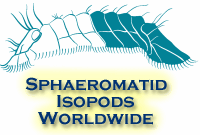| Abstract |
The life cycle of Anilocra pomacentri, an ectoparasitic isopod that infests the pomacentrid fish Chromis nitida, in the southern section of the Great Barrier Reef, is described in detail. Embryonated eggs developed through four ontogenic stages within the brood pouch (marsupium) of adult females. Released mancas were free-swimming and infective immediately to suitable hosts. Mancas were negatively buoyant and displayed strong negative rheotaxis and positive phototaxis. The appendix masculina that characterises the male stage was found on isopods between 4.1 and 7.2 mm in telson length. Males developed into females and remained attached permanently to their hosts. Adult females produced an average of three broads during their lifespan of 12-14 months. The number of mancas (average 3.2 mm in telson length) in each brood positively correlated with the telson length of the parent and ranged from 37 to 182. Isopod telson length was correlated positively with fish caudal fork length, which indicated that early infection of the host was followed by simultaneous growth of both host and parasite. In laboratory trials mancas fed successfully on small (14-29 mm length to caudal fork) C. nitida. Infection of larger fish was limited to transient attachment of mancas to the fins. Adult female isopods fed on host blood, with feeding limited to only those periods that correlated with the onset of vitellogenesis. Fish that carried feeding isopods showed a significant reduction in the number of circulating erythrocytes.
Australian Journal of Zoology 43(3) 271 - 281 |

















